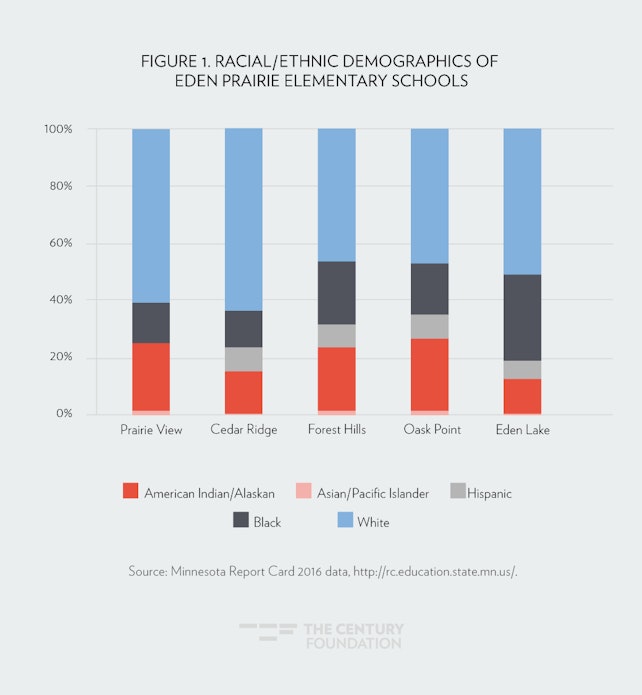Eden Prairie, Minnesota exemplifies many of today’s suburbs experiencing rapid demographic shifts. Like many locales around the country, the schools in this suburb of Minneapolis have reflected the move from racial homogeneity to increasing racial, socioeconomic, and cultural diversity. Within a twenty-year time period, the county’s percentage of white residents dropped nineteen points—from 94 percent in 1990 to 75 percent in 2010—as the community’s attributes and amenities attracted more minority and immigrant families.1 The attraction has included a highly touted school system. According to the Minnesota Report Card, in the 2015–2016 school year, the public schools in Eden Prairie enrolled nearly 9,000 students, 14.2 percent of whom were Asian, 14.2 percent of whom were black, nearly 7 percent of whom were Hispanic, and 64 percent of whom were white.2
The Eden Prairie Public School District (EPPSD) has leveraged its increased diversity with school attendance zones created in 2010 to reduce concentrated poverty and increase student achievement as well as operational efficiency. It has been six years since then-superintendent Melissa Krull and the school board undertook a voluntary elementary school boundary change process that generated national media attention, contentious public meetings, and, ultimately, the resignation of her and several school leaders as well as the turnover of all but one of seven board members. Though the process was not easy, it offers the opportunity to assess both the effort and the impact of adapting and embracing the dynamics of a changing community by designing an equity- and diversity-focused student assignment policy.
History of School Integration Efforts in EPPSD
To understand the context of the decision, it’s important to go back further in time to understand how the district’s priorities shifted as the community and the school system changed. Eden Prairie is one of eleven school districts in the Twin Cities region to participate voluntarily in the Western Metro Education Program (WMEP), which originated from a civil rights lawsuit due to intra-district segregation and inequity.3 According to the EPPSD’s most recent “Achievement and Integration Plan,” the district’s role in this collaborative was “to assist Minneapolis Public Schools, a racially isolated school district, desegregate their schools.”4 Through this effort, some district students attended the WMEP regional Magnet Schools, while the district received about one hundred students from Minneapolis through a program known as “The Choice is Yours.” The plan also notes that “Although the program’s qualifying requirement is low-income and a southwest Minneapolis location, 95 percent of the students are of color.”5
Embracing and expanding upon these integration efforts, the collaborative also offered culturally-responsive professional development. Through the collaborative, the district’s educators implemented a wide variety of new practices to meet the needs of its diversifying student population. However, by the end of the decade many district staff and leaders remained troubled by ongoing achievement gaps and an elementary school assignment plan that funneled an ever-increasing and disproportionate number of low-income and minority students into one of the four schools.6 EPPSD leaders realized that the pre-2010 school boundaries were an impediment to continued progress, and projections showed that inaction would only increase the racial and socioeconomic disparity in the years to come. Susan Eaton, who authored a “story from the field” on Eden Prairie as part of the One Nation Indivisible series, noted that the 2010 plan was “intended to reduce glaring and growing disparities in the racial and socioeconomic makeup between one school, where Somali, African American and lower income students were concentrated and three other elementary schools, which overwhelmingly enrolled white, middle class, and affluent students.”7
Stories of School Integration
View the profiles of school districts and charter schools pursuing socio-economic integration.The Future of Brown Is Multiracial
How My Family’s Immigration Story Connects to Integration
New York City Public Schools: Small Steps in the Biggest District
Chicago Public Schools: Ensuring Diversity in Selective Enrollment and Magnet Schools
Hartford Public Schools: Striving for Equity through Interdistrict Programs
Stamford Public Schools: From Desegregated Schools to Integrated Classrooms
Dallas Independent School District: Integration as Innovation
Jefferson County Public Schools: From Legal Enforcement to Ongoing Commitment
Eden Prairie Public Schools: Adapting to Demographic Change in the Suburbs
Champaign Schools: Fighting the Opportunity Gap
The Current Plan
After the EPPSD board directed the superintendent to generate potential solutions to address the concerns, Dr. Krull convened a working group of school stakeholders and community members.8 With assistance from the Institute on Metropolitan Opportunity (formerly the Institute on Race and Poverty) at the University of Minnesota Law School, the committee’s recommendations centered on moving from a K–4 to a K–6 model and redrawing boundaries to incorporate students from more and less affluent neighborhoods into each elementary school.9 Although the plan would require a significant number of school transfers in its starting year—with nearly 1,100 Eden Prairie students changing schools—it actually decreased the number of school transitions students would make during their K–12 experience and reduced the average commute time.10 The school board approved the plan on a 4-3 vote in December of 2010, and it went into effect for the 2010–2011 school year.11

After assessing the plan and the process undertaken, the National Coalition on School Diversity commended the plan and its architects for work “…under immense pressure, implement[ing] a forward-looking plan to achieve equity, efficiency, and high-quality schooling within economically and culturally and racially diverse schools.”12
Impact on Integration and Student Outcomes
As a result of the new attendance boundaries, Eden Prairie’s elementary schools are more socioeconomically and racially integrated today than they were before the plan. In the five years following the new student assignment plan, the wide variation in socioeconomic diversity at its neighborhood elementary schools decreased significantly.13 Similarly, the elementary schools today have more consistent racial diversity from elementary to elementary, with just over a fourteen point variation between the five schools’ populations of white students and less than a sixteen point variation between the populations of black students (see Figure 1).14
Tackling the issue of segregation also produced a number of opportunities borne out by research on the benefits of integrated schools. From 2012–2016, district-wide proficiency rates in all grades in math, reading, and science on the Minnesota Report Card have outperformed state averages. In 2013, the Minnesota Campaign for Achievement Now(MinnCAN) School and District Report Cards recognized five Eden Prairie schools as “top-performing public schools for Latino and Asian student performance.”15 Despite these gains, MinnCAN also reported that achievement gaps in EPPSD between white and black students at the secondary level remained well above state averages.16
Lessons for Other Districts
Today this community—touted before the change process for being a national “best place to live”—appears to have transitioned from a period of resistance by some to a broader acceptance of the student assignment changes.17 As time has passed and protests have begun to recede into memory, parent attitudes about the school system are positive. For example, in a random sample of 250 Eden Prairie parents conducted in 2015, “94 percent of respondents reported favorably that they ‘felt valued’ the last time they spent time in one of the Eden Prairie Schools to deal with an education issue.”18 The district also has moved forward with new leaders, a comprehensive strategic plan and broad public support for a 2014 levy.19 The current board has kept the zones intact despite early concerns that they would not sustain them.20 As principal Conn McCartan concluded in a 2014 story on Eden Prairie’s student assignment and demographic changes, “The nice part is to be able to look back on it and say, ‘See, when the dust settles, everybody is OK.’”21
For equity-minded educators and community leaders, the Eden Prairie story may show that the path to progress can be challenging, but also that it is worthwhile.
For equity-minded educators and community leaders, the Eden Prairie story may show that the path to progress can be challenging, but also that it is worthwhile. The EPPSD story illustrates far-reaching impacts that can help today’s students become tomorrow’s leaders. By designing a student assignment plan to ensure racial and socioeconomic diversity, the district hasn’t just prevented a rise in the concentration of poverty in one school or narrowed achievement gaps for many minority students; it has continued to strengthen its reputation for and commitment to academic excellence. In a 2013 presentation at a conference on school diversity, former superintendent Melissa Krull expressed this conclusion: “The fight is worth it. The challenge will make us stronger and our convictions deeper.”22

This profile is part of The Century Foundation’s Stories of School Integration series.
Notes
- Greg Toppo, and Paul Overberg, “Diversity in the Classroom,” USA Today, November 25, 2014, Accessed August 31, 2016. http://www.usatoday.com/story/news/nation/2014/11/25/minnesota-school-race-diversity/18919391/.
- “Minnesota Report Card,” Minnesota Department of Education, http://rc.education.state.mn.us/.
- Susan Eaton, “Not Your Father’s Suburb: Race and Rectitude in a Changing Minnesota Community,” Charles Hamilton Houston Institute for Race and Justice at Harvard Law School and Poverty & Race Research Action Council, February 2012, Accessed July 27, 2016, Onenationindivisible.org.
- N. Missaghi, “Achievement and Integration Plan,” Minnesota Department of Education, March 7, 2014, http://www.edenpr.org/cms/lib07/MN01909581/Centricity/Domain/47/EP%20Achievement%20and%20Integration%20Plan%20Revised%204%2023%2014.pdf, pp. 1-8.
- Ibid.
- “Eden Prairie Schools Demographics and Attendance Boundaries,” University of Minnesota School of Law, https://www1.law.umn.edu/uploads/b5/d5/b5d5a93e04a7bc04854aeebf6a36a89f/40b-Eden_Prairie_school_trends_and_boundaries.pdf, 2-30.
- Susan Eaton, “Not Your Father’s Suburb: Race and Rectitude in a Changing Minnesota Community,” Charles Hamilton Houston Institute for Race and Justice at Harvard Law School and Poverty & Race Research Action Council, Onenationindivisible.org. February 2012, Accessed July 27, 2016, Onenationindivisible.org.
- Greg Toppo and Paul Overberg. “Diversity in the Classroom.” USA Today, November 25, 2014. Accessed August 31, 2016. http://www.usatoday.com/story/news/nation/2014/11/25/minnesota-school-race-diversity/18919391/.
- “Eden Prairie Schools Demographics and Attendance Boundaries,” Institute on Race and Poverty, University of Minnesota School of Law, https://www1.law.umn.edu/uploads/b5/d5/b5d5a93e04a7bc04854aeebf6a36a89f/40b-Eden_Prairie_school_trends_and_boundaries.pdf, pp. 2-30.
- “Eden Prairie News Supports District Referendum,” Eden Prairie Schools, 2002, accessed August 21, 2016, http://www.edenpr.org/domain/641.
- Lindsey Seavert, “Eden Prairie School Board Approves Controversial Changes,” CBS Minnesota, December 21, 2010,
http://minnesota.cbslocal.com/2010/12/21/eden-prairie-school-board-approves-controversial-changes/. - “Building Support for Educators in Racially Changing Suburbs,” NCSD, accessed August 31, 2016, http://school-diversity.org/pdf/NCSD_Eden_Prairie_Statement.pdf.
- H. Potter, K.Quick, and E. Davies, “A New Wave of School Integration,” The Century Foundation, 2016, https://tcf.org/content/report/a-new-wave-of-school-integration/.
- “Minnesota Report Card,” Minnesota Department of Education, 2016, http://rc.education.state.mn.us/#demographics/orgId–999999000000__groupType–state__p–1/orgId–999999000000__groupType–state__p–1.
- Conrad, N. (2013, June 12). Eden Prairie Schools lead in Latino and Asian student performance. Sun Current. Retrieved September 16, 2016, from http://current.mnsun.com/2013/06/12/eden-prairie-schools-lead-in-latino-and-asian-student-performance/.
- “Study Gives Eden Prairie Schools Low Grades for Achievement Gap,” Schools, May 7, 2013, accessed August 31, 2016, http://patch.com/minnesota/edenprairie/study-gives-eden-prairie-schools-low-grades-for-achievement-gap.
- Greg Toppo and Paul Overberg, “Diversity in the classroom: SIDES SQUARE OFF IN MINNESOTA” USA Today, November 25, 2014
http://www.usatoday.com/story/news/nation/2014/11/25/minnesota-school-race-diversity/18919391/.
- Eden Prairie School District 272 Superintendent Monitoring Report (Rep.). (n.d.). Retrieved September 16, 2016, from http://www.edenpr.org/cms/lib07/MN01909581/Centricity/domain/117/board policies/reports/el/EL 2.3 Treatment of Parents Report-11.24.15.pdf.
- “Eden Prairie News Supports District Referendum,” 2014, accessed August 21, 2016, http://www.edenpr.org/domain/641.
- “Eden Prairie News Supports District Referendum,” 2014, accessed August 11, 2016, http://www.edenpr.org/domain/641.
- Greg Toppo and Paul Overberg, “Diversity in the classroom: SIDES SQUARE OFF IN MINNESOTA” USA Today, November 25, 2014
http://www.usatoday.com/story/news/nation/2014/11/25/minnesota-school-race-diversity/18919391/. - Melissa Krull, “Utilize Capacity and Increase Achievement” (presentation at the Looking Back, Moving Forward Conference, University of Richmond, Richmond, Virginia, March 13-14, 2013).
http://spcs.richmond.edu/centers-institutes/leadership-education/moving-forward/presentations.html.











